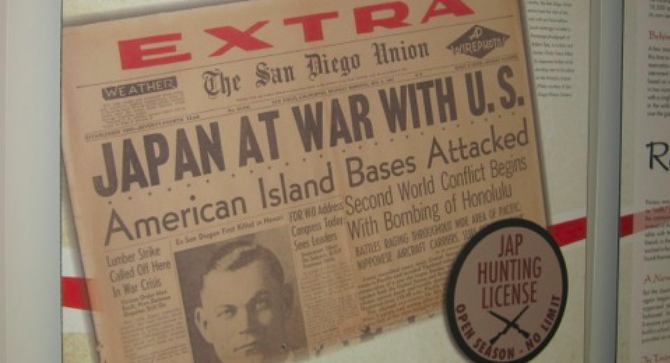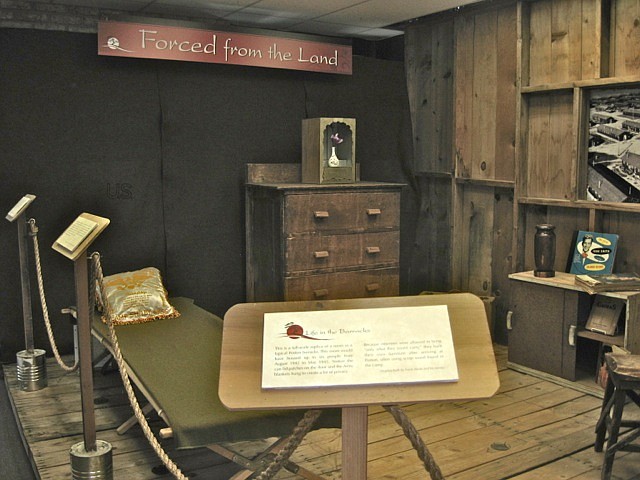 Facebook
Facebook
 X
X
 Instagram
Instagram
 TikTok
TikTok
 Youtube
Youtube

A cot, a hand-hewn chest of drawers, and tight quarters for six men — this is the display that dominates the visual and conceptual space of the current exhibit in the Chula Vista Heritage Museum. This Land is My Land, Japanese Americans in Chula Vista features a replica of a Japanese internment camp barrack built by Frank Wada to enable his grandchildren to understand the internment experience.

Docent Pam Kesegi pointed out that when Japanese-American men like Wada were rounded up in the middle of the night by the United States government after Pearl Harbor, they were allowed to take only what they could carry.
Steeped in history from this period, Kesegi reminds the museum-goer that families lost their homes and most of them lost their belongings. Many families preferred destroying their possessions, Kesegi said, rather than sell them for the pennies they were offered.
According to the exhibit brochure, “Most of the 450 Japanese from Chula Vista spent the duration of the war in Poston, a hastily built ‘internment camp’ in the Arizona desert. There, they created new homes in the rustic barracks and a new community inside the barbed wire.”
Though the museum building is small, the exhibit makes creative use of space. Anti-Japanese cartoons created by Dr. Seuss (for which he later apologized) are mounted on one wall.
On another wall, a monitor rolls two videos that juxtapose the official story of the internment as told by the United States Office of War with a 15-minute clip from a series called “Once Upon a Camp.”
The first video gives a positive interpretation of the need for internment and shows Japanese Americans leading normal and fulfilled lives in the camps.
The second video features grimmer scenes from Poston and voice- overs from children reading letters from the camp. The children were corresponding with San Diego librarian Clara Breed.
Kesegi filled in the background. She said Breed had been a children’s librarian and had a relationship with many of the children who were rounded up. When she heard they were being shipped out, she met them at the train and handed them pre-addressed envelopes and kept up a correspondence with many children during World War II. A book about these exchanges has recently been published: Dear Miss Breed: True Stories of the Japanese American Incarceration During World War II and a Librarian Who Made a Difference.
The exhibit also celebrates many of the contributions Japanese Americans have made to the community and the local economy, including garnering Chula Vista the title of “Celery Capital of the World.”
Peter Watry, who cofounded the museum with Frank Roseman, was on hand for the museum tour. He advised people to get into the museum soon, as the exhibit ends in May. The next yearlong exhibit will be put on by the Chula Vista Police Department.
The Chula Vista Heritage Museum is located at 360 Third Avenue. Museum. Hours are 12:00 to 4:00 p.m. on Tuesday and Thursday, 12:00 to 3:00 p.m. on Saturday.


A cot, a hand-hewn chest of drawers, and tight quarters for six men — this is the display that dominates the visual and conceptual space of the current exhibit in the Chula Vista Heritage Museum. This Land is My Land, Japanese Americans in Chula Vista features a replica of a Japanese internment camp barrack built by Frank Wada to enable his grandchildren to understand the internment experience.

Docent Pam Kesegi pointed out that when Japanese-American men like Wada were rounded up in the middle of the night by the United States government after Pearl Harbor, they were allowed to take only what they could carry.
Steeped in history from this period, Kesegi reminds the museum-goer that families lost their homes and most of them lost their belongings. Many families preferred destroying their possessions, Kesegi said, rather than sell them for the pennies they were offered.
According to the exhibit brochure, “Most of the 450 Japanese from Chula Vista spent the duration of the war in Poston, a hastily built ‘internment camp’ in the Arizona desert. There, they created new homes in the rustic barracks and a new community inside the barbed wire.”
Though the museum building is small, the exhibit makes creative use of space. Anti-Japanese cartoons created by Dr. Seuss (for which he later apologized) are mounted on one wall.
On another wall, a monitor rolls two videos that juxtapose the official story of the internment as told by the United States Office of War with a 15-minute clip from a series called “Once Upon a Camp.”
The first video gives a positive interpretation of the need for internment and shows Japanese Americans leading normal and fulfilled lives in the camps.
The second video features grimmer scenes from Poston and voice- overs from children reading letters from the camp. The children were corresponding with San Diego librarian Clara Breed.
Kesegi filled in the background. She said Breed had been a children’s librarian and had a relationship with many of the children who were rounded up. When she heard they were being shipped out, she met them at the train and handed them pre-addressed envelopes and kept up a correspondence with many children during World War II. A book about these exchanges has recently been published: Dear Miss Breed: True Stories of the Japanese American Incarceration During World War II and a Librarian Who Made a Difference.
The exhibit also celebrates many of the contributions Japanese Americans have made to the community and the local economy, including garnering Chula Vista the title of “Celery Capital of the World.”
Peter Watry, who cofounded the museum with Frank Roseman, was on hand for the museum tour. He advised people to get into the museum soon, as the exhibit ends in May. The next yearlong exhibit will be put on by the Chula Vista Police Department.
The Chula Vista Heritage Museum is located at 360 Third Avenue. Museum. Hours are 12:00 to 4:00 p.m. on Tuesday and Thursday, 12:00 to 3:00 p.m. on Saturday.
Comments